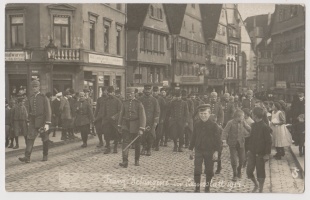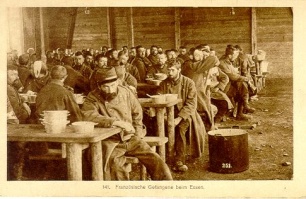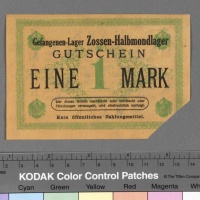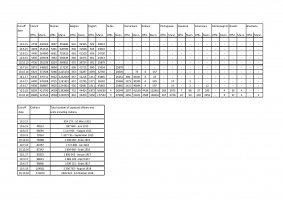Introduction↑
At least seven, and perhaps as many as eight to nine million soldiers in total were taken prisoner in 1914-1918.[1] In German prisoner of war camps alone, the military authorities estimated that there were approximately 2.4 million soldiers from thirteen nations by the end of the war; the biggest nationality among these captives were the over 1.4 million Russians taken prisoner by Germany by October 1918, followed by over half a million French prisoners.[2] In 1914, Germany captured dramatically high numbers of prisoners, particularly at the battles of Tannenberg and the Masurian Lakes. By 1915, Germany already held over a million captives.
 Table 1: Table of Prisoners of War in Germany until 10 October 1918 (only the officially reported prisoners are listed)[3]
Table 1: Table of Prisoners of War in Germany until 10 October 1918 (only the officially reported prisoners are listed)[3]
Historiography↑
In spite of these immense numbers, captivity was for decades a forgotten aspect of the war experience. Prisoners of war from the Great War were largely ignored in the historiography of all the belligerent states. In the German case, the catastrophic experience of the Second World War and the long campaign into the 1950s to obtain the release of German Second World War prisoners from the Soviets, left little room for interest in the treatment of prisoners of war in 1914-1918. This first changed in the 1990s: in Germany, research into German crimes against prisoners of war and forced labourers in 1939-1945 raised the question of possible historical continuities linking the two world wars[4] and German reunification allowed access to new source materials. Internationally, the interpretation of the First World War broadened to include new research on both the everyday experience of the conflict and its cultural dimensions, including its impact on home front societies beyond the battlefront, a shift which facilitated new work on prisoners of war. Above all new research paradigms emerged: what role the First World War played in the development of "total war" in the 20th century became a central question.[5]
The German home front and Etappen camp systems↑
As a result of these new research perspectives many important aspects of the German prisoner of war camp system – as well as the development of forced labour in the First World War[6] – have now been intensively researched.[7] It is now clear that the prisoner of war camp system within Germany developed from a largely improvised scattering of ad hoc, relatively primitive camps in 1914-1915, frequently located at or near existing military barracks and urban centres, to a relatively sophisticated system of major, industrial scale camps (Stammlagern) by 1916. This included a complex network of smaller, more mobile, working unit affiliates (Arbeitskommandos), allowing prisoner labour to be deployed to where it was most needed by the wartime economy: several German economic sectors, including agriculture, heavy industry in the Ruhr, mining, quarrying and land drainage became very dependent on prisoner labour during the war. Prisoner labour was used on an enormous scale: by August 1916, 90 percent of all prisoners in Germany were employed outside their camp in working units.[8]
While in 1914-1915 prisoner nationalities were mixed, the German authorities later opted to partly segregate nationalities within large camps into different sections or barracks. From the very start of the war, officer prisoners of war were segregated in specially designated officer camps where facilities were better than in the camps for other rank captives. Among the biggest camps within Germany were Limburg, Heilsberg, Schneidemühl, Gardelegen, Merseburg, Lamsdorf, Neuhammer, Münster, Friedrichsfeld, Güstrow, Parchim, Hameln, Soltau, Cassel-Niederzwehren, Worms, Danzig-Troyl, Hammerstein, Darmstadt, Tuchel, Saarbrücken and Senne, to each of which over twenty thousand prisoners were assigned.[9]
As well as home front camps, the German army also established prisoner of war labour companies for other rank prisoners in the front hinterland areas (Etappen) in occupied French, Belgian and Russian territory. The first prisoner of war labour companies on the Western Front were established by the German army in 1915, containing Russian prisoner of war labourers transferred to the west. By 1916, German prisoner of war labour companies at the Western Front and its hinterland contained multiple prisoner nationalities, including British and French captives. In total, German prisoner of war labour companies on the Western Front contained over 250,000 prisoner workers by 1916. These prisoners were often mistreated and generally endured worse working and living conditions than their counterparts in Germany. In 1918, conditions in German army prisoner of war labour units on the Western Front deteriorated badly, due to food shortages and the strain of incorporating over 70,000 British captives taken in the first weeks of the Ludendorff Offensive, the majority of whom were sent directly into front line labour companies, where they endured frequent beatings and did not usually have access to food parcels or post from home. Prisoner of war labour companies on the Western Front were used by the German army for heavy manual labour, maintaining roads and railways, lines of communication and loading and unloading supplies. Total death rates for prisoners of war in these Western Front labour companies remain uncertain but witness evidence suggests they were high in 1917-1918.[10] Little is known still of conditions in prisoner of war labour companies working for the German army on the Eastern Front.
The management of prisoner of war labour varied between the front and the home front captivity systems. In the prisoner of war labour company system, operating at the front line and Etappen areas in the hinterland to the front, a variety of different military levels and army administrative departments controlled the treatment of prisoners. Although aware of Prussian Ministry of War general directives on prisoner of war treatment emanating from Berlin they had considerable leeway to ignore them and the prisoners in their charge were effectively under the complete control of the German army in the field. Within Germany proper, however, captivity administration was organized differently, by over twenty regional district army commanders and their subordinate administrative departments, with considerable local powers, working together with a number of Prussian Ministry of War sub-departments in Berlin, as well as the regional Ministries of War, where one existed, such as in Bavaria or Saxony. Although the Unterkunftsdepartment at the Prussian Ministry of War led by General Emil Friedrich was theoretically meant to oversee the system, this administrative complexity led to confusion, as well as overlap, in terms of who had competence to manage particular aspects of prisoner treatment. Uta Hinz has referred to how this complex administrative system suffered from "bureaucratic fragmentation," something which increased as the numbers of prisoners employed in the German war economy rapidly rose. The military authorities within Germany responsible for prisoner treatment stated that prisoners of war were subject to German military law and German army disciplinary regulations, which was in accordance with international law. This legal status continued until the end of the war, although the implementation of these legal controls on the ground was far from uniform, particularly during the early years of the war.
In sum, between 1914-1918, Germany developed a very sophisticated home front system of captivity which utilised technological advances such as barbed wire and improved hygiene knowledge, logistical advances in railways and bureaucratic advances in maintaining records, to distribute and manage a forced labour cohort of over 2 million men, the vast majority of whom survived the war, although death rates were significantly high for Romanian and Italian prisoners in German captivity. There was relatively little disease in German prisoner of war camps, with the exception of a major typhus outbreak in 1915 and the Spanish influenza outbreak in 1918. Indeed, the major organizational challenge which the German authorities faced with regard to prisoners was not disease but food supply. According to international law, set out in The Hague Conventions, prisoners of war were to be fed the same rations as the troops of the captor army. However, as early as 1915, the German military administration, aware that in a long war with an on-going Allied maritime blockade Germany would face a shortage of food supplies, introduced measures to economise on food provided to prisoners. Initially in 1915, the quality of prisoner food was reduced and the prisoner of war bread ration was made equivalent to that provided to German civilians, not German troops; a break with international law. From 1917, in many of the main home front prisoner of war camps the minimum calorie ration set by the German administration was no longer being provided to prisoners. Those working outside the camps in prisoner of war working units in Germany often fared better, receiving better food. However, during the war, all prisoners, in camps or working units in Germany became increasingly dependent on food parcels from their home state in order to survive. German prisoners of war in enemy hands also benefited as the parcel system was allowed on a "reciprocal" basis. In addition, parcels helped to alleviate the increasing economic difficulties that Germany faced in feeding its prisoners of war as the conflict went on.
German captivity in the Great War thus combined forced labour with relatively high survival rates for most prisoner nationalities, presenting historians with a conundrum: how to interpret its combination of harsh discipline, inadequate rations and heavy forced labour on the one hand with the modernisation of prisoner living conditions and relative lenience in permitting prisoners access to leisure and educational activities within home front camps, on the other. For historians this paradox lies at the heart of Great War captivity in Germany. There is generally the consensus that between 1914 and 1918 captivity underwent fundamental changes. Yet the causes of these radicalisation processes, as well as the extent of their impact, have been emphasised in different ways by historians.
Totalisation↑
One interpretation situates German prisoner of war policy in terms of an increasing process of ideological and economic totalisation of both war practices and imagery. Uta Hinz contends that an ever-widening definition of what constituted wartime necessity led to radicalisation processes,[11] whose impact, however, did not affect all areas of prisoner of war treatment to the same degree.[12]Totalisation describes a structural shift in how war is waged which leads to the breakdown of the boundaries between the front and home front, as well as between combatant and non-combatant, being the result of an ever more radical mobilisation, control and exploitation of resources, as the historians Stig Förster and Roger Chickering have argued.[13]
Elements of such totalisation are identifiable in Germany from 1915 on. The original purpose of captivity, to weaken the enemy militarily by reducing its combatant numbers through capture, decreased in importance. A shift from seeing prisoners in military terms to seeing them in economic terms took place. Until 1915, enemy prisoners were perceived in largely military terms, held in extremely provisional, military-run camps and the German authorities saw prisoners in terms of captive soldiers rather than labourers; illustrated by the fact that one of the main problems that the German captor army focused on up to this point was how to maintain military "discipline" among captives. From 1915 on, however, other rank soldiers from the over 100 main prisoner of war home front camps in Germany were employed in agriculture and, from 1916 on, increasingly in industrial working units where in some cases working conditions were very poor as wartime output demands led to the attenuation of peacetime safety norms in mines and factories. The central aim now was to exploit prisoners’ labour as comprehensively as possible, according to the military assessment of what was economically necessary – an assessment that was subject to ever-decreasing constraints.
From spring 1916, all prisoners were classified according to their work capability, with only those categorised as "heavy manual labourers" still receiving the full food ration; prisoners’ work skills were also identified so that those with previous experience as mechanics or miners could be used in the relevant work sectors. The classifications regarding who was fit enough to work and what kinds of work they could do became increasingly broad as the war continued and ministerial instructions regarding how to increase worker output became successively harsher. The prohibition on employing prisoners on tasks connected with their captor state’s war effort which was enshrined in Article 6 of the annex to the 1907 Hague Convention respecting the Laws and Customs of War on Land was increasingly ignored, both within Germany and in the prisoner of war labour companies in the front hinterland. Even though the food situation in Germany was precarious in 1916, and progressively worsened in the following years, no major exchange of prisoners of war who were capable of working took place, nor did the separate Brest-Litovsk peace agreement with Russia in 1918 lead to the repatriation of Russian prisoners of war from Germany as these were too important a labour resource to lose.
The status of captured soldiers was increasingly defined by their utilization in the war economy. This structural totalisation proceeded in stages and even by 1917-1918 it did not affect all parts of the fragmented German prisoner of war system to the same extent. Two-thirds of all prisoners of war employed in Germany worked in agricultural working units where military control was weakest and the food supply situation remained tolerable. This latter fact was crucial for prisoners of war who received little or no material support from their home states, particularly the over 1.4 million Russian soldiers in German captivity, a large proportion of whom worked in agriculture. According to the military authorities, guards’ and employers’ treatment of prisoners working in agriculture was far too "lax." Indeed, economic totalisation – which necessitated prisoner labour – in some ways impeded brutal treatment as prisoner workers could do more work when adequately fed and cared for. Both civilian employers and the military were forced to recognize that incentives improved prisoner work performance more than repression or punishment.
Brutalisation↑
A second approach by historians sees prisoner of war treatment in the context of a comprehensive wartime cultural brutalisation with regard to the treatment of non-combatants.[14] It focuses in particular upon the question of violence against prisoners, examined within an international perspective.[15] Heather Jones emphasises the processes of reciprocal brutalisation, evident in reprisals against prisoners. Jones also considers the extensive development of a prisoner of war labour company system by Germany in 1915-1918 as part of a "drive to extremes" and argues that radicalisation processes were not only economic but were also driven by military cultural attitudes and practices, which in the German case remained beyond the limits of civilian political control.
Indeed, totalisation was facilitated by certain brutalisation shifts towards harsher attitudes to captives: prisoner of war treatment was directly affected by the incendiary escalation of the propaganda war which began at the very outset of the conflict. Reports of breaches of the laws of war by the enemy radicalised the image of the enemy and led to a brutalisation of reprisal practices against captives. In particular, Jones points to two incidents of reprisals: first, in 1916, when the German army forced British and French prisoners to work behind the Eastern Front trenches in freezing conditions in retaliation for the French use of German prisoner labour in North Africa and the British use of German prisoner labour in French ports; second, in 1917, when the German army forced British and French captives to work directly behind the lines on the Western Front, without access to proper food or shelter, in retaliation for French and British use of German prisoner labour in close proximity to the combat zone, (including, by the French, upon the Verdun battlefield). For Jones, these offer two examples of the extreme ruthlessness that developed within the German command regarding the kinds of extreme official prisoner of war reprisals that could be used. Overall, during the war, brutalisation particularly affected prisoner of war treatment in those areas which were under the exclusive influence of the German army leadership and commanders. Prisoners employed in prisoner of war labour companies at the front or in the front line hinterland suffered from severe overwork which was not subject to any form of checks and they were sometimes made to work in areas that lay within the firing zone and beaten to force them to work.
However, while brutalisation was clearly occurring, particularly with regard to attitudes to prisoner labourers working for the army in the hinterland of the front and with regard to reprisals, it was far from universal within the German home front camp system where the majority of men captured by Germany were held. The extent to which prisoners in these home front camps became the object of enmity and violence varied according to the stage of the war and differed from camp to camp and between prisoner nationalities. Individual prison camp commandants wielded a large amount of power in the German wartime state and as a result the level of mistreatment depended very much on the character of the commandant in charge of a given camp. Up to 1918, the media and wartime propaganda sometimes portrayed prisoners as the "enemy within the country", and they did depict them as epitomising different degrees of "civilisation," with Russian prisoners, in particular, often mocked as illiterate and unclean and colonial non-white prisoners of war depicted as "savage." During the years 1914 and 1915 there is also evidence that British and Russian prisoners in particular were mistreated using harsh physical punishments in some home front camps -contrary to disciplinary regulations.
Despite ministerial decrees against physical violence and increasing formal regulation, disciplinary practices remained a grey area in terms of the day-to-day reality on the ground. In contrast, prisoners from a number of distinct cultural, national, or ethnic identities were given privileged treatment to entice them to change sides and support Germany: among these groups were Irish prisoners, who were concentrated in Limburg camp in 1915 and subjected to a largely unsuccessful propaganda campaign to force them to change sides to fight against Britain; Muslim prisoners captured fighting with the British, French and Russian armies who were subject to propaganda visits by Turkish dignitaries and some of whom were ultimately sent to fight in the Ottoman army; and finally ethnic Germans captured fighting with the Russian army who were encouraged to become naturalised German citizens. Ultimately none of these policies was particularly successful; most prisoners continued to support their state of origin. In contrast, Italian prisoners were subject to particularly harsh treatment as Italy was perceived as having betrayed Germany by entering the war on the side of the Allies and, from 1917 on, Romanian prisoners of war were frequently singled out to be sent directly to work on the Western Front in very poor conditions with high death rates.
Overall, within the Reich’s borders, there is evidence that the authorities did initiate a brutalisation of prisoner of war treatment in the last two years of the war through their ever harsher orders on how prisoner labour was to be employed. According to international law prisoners were only to be put to work on tasks to which they were humanely physically suited; however, from 1917 on, this stipulation was frequently disregarded. In industrial Kommandos or working units there were also frequent complaints from prisoners that they were subject to punishments and violence if they failed to manage the heavy workload demanded of them. For the German military authorities the maintenance of legal or humanitarian standards became increasingly dispensable, dependent only upon the "needs of the war effort." The two main factors that prevented this development from radicalising further were political and practical: the political interest in maintaining prisoner of war labour output and the practical reality of the decentralised nature of the prisoner of war system in the Reich. The visible harshening of prisoner of war policies from 1916-1917 onwards was not possible to fully implement in a regionally and military-bureaucratically fragmented system.
Humanitarianism↑
Finally, wartime humanitarian actions also prevented further radicalisation. First, international law provided a basic level of protection for captives. The German Reich had signed both the 1899 and 1907 Hague Conventions on Land Warfare which, for the first time, defined international standards for prisoner of war treatment, albeit in broad general terms. Second, a form of external supervision of prisoner treatment developed with the agreement of all belligerents to the introduction of camp inspections by delegations from neutral states from 1915 on, even if this was also relatively limited in practice and limited to prisoner of war camps within the German Reich, excluding those in occupied territory and also included very few inspections of prisoner workplaces or working units located away from the main camps. Third, the Great War saw a dramatic increase in NGO activity. This was particularly true of the International Committee of the Red Cross which established an international prisoner of war aid effort based in Geneva that provided information on prisoners and organised its own camp inspections. The scale of its aid operations was immense and it increasingly expanded as the war went on. Likewise the Young Men’s Christian Association (YMCA) provided significant aid to prisoners in Germany. Aid to prisoners also came from national relief organisations in their home countries. In sum, aid was crucial to ensuring prisoners’ physical and mental welfare – and, indeed, survival.
A trend within the German home front camp system towards humanising captivity is also visible, particularly in 1915 when the desolate conditions in German camps in 1914-1915 with regard to accommodation, hygiene and medical care improved markedly. The military authorities played a decisive role in this, their motives including not only the fear that the typhus epidemic of that year might spread to the civilian population in Germany and that the Allies might make use of poor prisoner treatment in Germany in their propaganda, but also the desire to present Germany at war as a civilized nation with a well-organised war effort. Additionally, private organisations and individuals were also engaged in improving the cultural and spiritual welfare of captives, particularly religious groups; indeed, in many large camps significant amenities for captives developed through collaborative efforts between prisoners, charities and the camp authorities, such as libraries, chapels or synagogues, printing facilities where prisoners produced their own newspapers, sports facilities, football grounds, orchestras, choirs or theatres and organized post and parcel distribution systems. Although the situation remained far bleaker for prisoners held in prisoner of war labour companies working for the German army in front hinterlands and occupied territories.
In the long-term, however, the double-edged principle of "reciprocity" proved more effective in ensuring basic standards of prisoner treatment were maintained than the motive of humanity or even the framework provided by the new international laws of war. Germany only accepted many of the humanitarian initiatives to protect prisoners in Germany on the grounds that these would equally benefit German captives in Allied hands. The inspections of prisoner of war camps were established on the grounds of reciprocity and the reciprocity principle facilitated bilateral agreements on prisoner of war treatment between Germany and individual enemy belligerent states.
Conclusion↑
To conclude, it is clear that captivity in Germany during the Great War introduced important conceptual changes to how prisoners of war were viewed and managed. Unlike previous conflicts, the Great War saw the introduction of a sophisticated system for utilising forced labour in wartime, with the state and the military operating together to facilitate this. The scale and longevity of this forced labour system marked a decisive break with past wars, as did the very modern and technologically advanced types of prisoner of war camps that Germany constructed. This was the context in which new dynamics of totalisation and brutalisation took place. The key differences between this system and the 1939-45 war, however, were the strength of the humanitarian dynamic within the captivity sphere during the war, which safeguarded prisoners’ interests, as well as the lack of an overall ideological theoretical framework for radicalisation. Brutalisation during the Great War was always limited to certain particular sectors of the prisoner of war system or to individual camp circumstances. It was frequently ad hoc, and was never defined or formulated in terms of an overall coherent centralised policy or racialised doctrine for the whole camp system. This meant that the captivity space in Germany during the Great War remained very different to that of 1939-45, even if dangerous precedents had been set.
Uta Hinz, Heinrich-Heine-Universität Düsseldorf and Heather Jones, London School of Economics and Political Science
Section Editor: Christoph Cornelißen
Notes
- ↑ Oltmer, Jochen: Einführung, in: Oltmer, Jochen (ed.): Kriegsgefangene im Europa des Ersten Weltkriegs, Paderborn 2006, p. 11.
- ↑ Hauptstaatsarchiv (HStA) Stuttgart, M 1/6 - 1430: Preußisches Kriegsministerium: Nachweisung der Zahl der Kriegsgefangenen nach dem Stande vom 10.10.1918. For the statistic on Russian captives see: Doegen, Wilhelm: Kriegsgefangene Völker. Der Kriegsgefangenen Haltung und Schicksal in Deutschland, Berlin 1921, pp. 28-29.
- ↑ Data based on Doegen, Wilhelm: Kriegsgefangene Völker, Der Kriegsgefangenen Haltung und Schicksal in Deutschland, Tafel G., Berlin 1921, pp. 28-29.
- ↑ Herbert, Ulrich: Fremdarbeiter. Politik und Praxis des "Ausländer-Einsatzes" in der Kriegswirtschaft des Dritten Reiches, Berlin 1985, pp. 24-35.
- ↑ Förster, Stig: Introduction, in: Chickering, Roger/Förster, Stig (eds.): Great War, Total War. Combat and Mobilization on the Western Front, Cambridge 2000, pp. 1-19.
- ↑ See Oltmer, Jochen: Bäuerliche Ökonomie und Arbeitskräftepolitik im Ersten Weltkrieg. Beschäftigungsstruktur, Arbeitsverhältnisse und Rekrutierung von Ersatzarbeitskräften in der Landwirtschaft des Emslandes 1914-1918, Bentheim 1995; Rawe, Kai: ‚...Wir werden sie schon zur Arbeit bringen‘. Ausländerbeschäftigung und Zwangsarbeit im Ruhrkohlenbergbau während des Ersten Weltkrieges, Essen, 2005; Thiel, Jens: "Menschenbassin Belgien". Anwerbung, Deportation und Zwangsarbeit im Ersten Weltkrieg, Essen 2007; Spoerer, Mark: The mortality of Allied prisoners of war and Belgian civilian deportees in German custody during the First World War. A reappraisal of the effects of forced labour, in: Population Studies, vol. 60 (2006), No. 2, pp. 121-136.
- ↑ Oltmer, Bäuerliche Ökonomie und Arbeitskräftepolitik, 1995; Mitze, Katja: Das Kriegsgefangenenlager Ingolstadt während des Ersten Weltkriegs, Univ. Diss. Münster 1999; Hinz, Uta: Gefangen im Großen Krieg. Kriegsgefangenschaft in Deutschland 1914-1921, Essen 2006; as well as Jones, Heather: Violence against Prisoners of War in the First World War. Britain, France and Germany 1914-1920, Cambridge 2011.
- ↑ Hinz, Gefangen im Großen Krieg 2006, p. 128.
- ↑ Doegen, Kriegsgefangene Völker 1921, pp. 12-19.
- ↑ For further information see Jones, Violence Against Prisoners of War 2011, Part Two.
- ↑ This is the argument in Uta Hinz’s analysis which focuses upon the development of camps in Germany: Hinz, Gefangen im Großen Krieg 2006.
- ↑ Ibid., in particular, pp. 356-363; Abbal, Odon: Soldats oubliés: les prisonniers de guerre français, Bez-et-Esparon 2001, p. 120f.
- ↑ Förster, Stig: Introduction, in: Chickering, Roger/Förster, Stig (eds.): Great War, Total War. Combat and Mobilization on the Western Front, Cambridge 2000, pp. 1-19.
- ↑ See: Becker, Annette: Oubliés de la Grande Guerre. Humanitaire et culture de guerre 1914-1918. Populations occupées, déportés civils, prisonniers de guerre, Paris 1998, p. 20 and p. 90.
- ↑ For the first systematic comparison see: Jones, Violence against Prisoners of War 2011; for the broader context of prisoner treatment in terms of war violence in general, see: Kramer, Alan: Dynamic of Destruction. Culture and Mass Killing in the First World War, Oxford 2007, pp. 62-68; Kramer, Alan: Prisoners in the First World War, in: Scheipers, Sibylle (ed.): Prisoners in War, Oxford 2010, pp. 75-90.
Selected Bibliography
- Abbal, Odon: Soldats oubliés. Les prisonniers de guerre français, Bez-et-Esparon 2001: E & C.
- Auerbach, Karl: Die russischen Kriegsgefangenen in Deutschland (von August 1914 bis zum Beginn der Grossen Sozialistischen Oktoberrevolution), thesis, Potsdam 1973: Pädagogische Hochschule Potsdam.
- Becker, Annette: Oubliés de la Grande guerre. Humanitaire et culture de guerre, 1914-1918. Populations occupées, déportés civils, prisonniers de guerre, Paris 1998: Éd. Noêsis.
- Hinz, Uta: Gefangen im Grossen Krieg. Kriegsgefangenschaft in Deutschland 1914-1921, Essen 2006: Klartext Verlag.
- Jones, Heather: Violence against prisoners of war in the First World War. Britain, France, and Germany, 1914-1920, Cambridge; New York 2011: Cambridge University Press.
- Oltmer, Jochen (ed.): Kriegsgefangene im Europa des Ersten Weltkriegs, Paderborn 2006: Schöningh.
- Pöppinghege, Rainer: Im Lager unbesiegt. Deutsche, englische und französische Kriegsgefangenen-Zeitungen im Ersten Weltkrieg, Essen 2006: Klartext.
- Speed, Richard Berry: Prisoners, diplomats, and the Great War. A study in the diplomacy of captivity, New York 1990: Greenwood Press.
- Spoerer, Mark: The mortality of Allied prisoners of war and Belgian civilian deportees in German custody during the First World War. A reappraisal of the effects of forced labour, in: Population Studies 60/2, 2006, pp. 121-136.


















